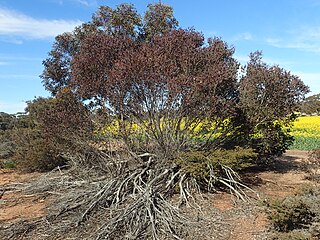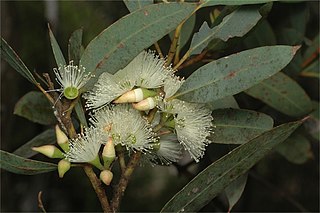
Eucalyptus eremophila, commonly known as the sand mallet or tall sand mallee, is a species of mallet that is endemic to semi-arid regions of Western Australia. It has smooth pale brown and greyish bark, narrow lance-shaped to elliptical adult leaves, flower buds arranged in groups of between seven and eleven with an elongated operculum, and cup-shaped to barrel-shaped fruit.

Eucalyptus arachnaea, commonly known as the black-stemmed mallee, is a mallee or tree that is endemic to Western Australia. It has rough, stringy bark, lance-shaped leaves and white flowers in groups of up to thirteen.

Eucalyptus calcicola, commonly known as the Boranup mallee, Harry Butler's mallee or Hamelin Bay mallee, is a mallee that is endemic to a small area in the south-west of Western Australia. It has smooth, pale greenish bark, lance-shaped to curved adult leaves, flower buds in groups of seven or nine, white flowers and ribbed, cup-shaped to hemispherical fruit.

Eucalyptus capillosa, commonly known as wheatbelt wandoo, or mallee wandoo, is a species of tree or mallee that is endemic to Western Australia. It has smooth, grey bark, lance-shaped to elliptic adult leaves, spindle-shaped flower buds in groups of nine to thirteen, white flowers and barrel-shaped to cylindrical fruit.

Eucalyptus gardneri, commonly known as blue mallet, or woacal, is a species of mallet with flower buds in groups of between seven and eleven, creamy yellow or pale lemon-coloured flowers and cylindrical to barrel-shaped fruit.

Eucalyptus georgei, commonly known as Hyden blue gum, is a species of tree or mallet that is endemic to Western Australia. It has smooth bark, glossy green, lance-shaped adult leaves, glaucous flower buds in groups of between seven and eleven, creamy white flowers and conical to cup-shaped fruit.

Eucalyptus ligulata, commonly known as Lucky Bay mallee, is a mallee that is native to a few small areas along the south coast of Western Australia. It has smooth bark on the trunk and branches, narrow lance-shaped leaves, flower buds in groups of between nine and thirteen, creamy white flowers and cup-shaped or barrel-shaped fruit with shallow ribs on the sides.

Eucalyptus luteola is a species of mallee that is endemic to a small area of Western Australia. It has smooth grey bark with rough greyish ribbons near the base, linear to narrow lance-shaped adult leaves, flower buds in groups of eleven to thirteen, lemon-coloured flowers and cylindrical to barrel-shaped fruit.
Eucalyptus mimica is a species of mallet that is endemic to a small area of Western Australia. It has smooth, shiny bark, linear to narrow elliptical leaves held erect, flower buds in groups of three and conical fruit with ribbed sides.

Eucalyptus myriadena, also known as blackbutt, is a species of mallee or tree that is native to Western Australia. It has rough, coarse flaky bark on part of the trunk, smooth bark above, linear to narrow lance-shaped adult leaves, flower buds in groups of between nine and thirteen, white flowers and narrow cylindrical to barrel-shaped fruit. It is widely distributed in the wheatbelt and goldfield areas of the state.

Eucalyptus phaenophylla, also known as common southern mallee, is a species of mallee that is endemic to Western Australia. It has smooth bark, linear to narrow lance-shaped or narrow elliptical adult leaves, flower buds in groups of up to thirteen, pale lemon-coloured flowers and barrel-shaped, cylindrical or conical fruit.
Eucalyptus pluricaulis, commonly known as the purple-leaved mallee, is a species of mallee that is endemic to Western Australia. It has smooth bark, dull bluish green, lance-shaped leaves, flower buds in groups of between nine and fifteen, pale yellow flowers and cylindrical to barrel-shaped fruit.
Eucalyptus subangusta is a species of tree, mallee or mallet that is endemic to the southwest of Western Australia. It has smooth bark, narrow lance-shaped leaves, flower buds in groups of up to nineteen, white flowers and cup-shaped to barrel-shaped fruit.
Eucalyptus thamnoides is a species of mallee that is endemic to south western Western Australia. It has smooth bark, lance-shaped adult leaves, flower buds in groups of seven, cream-coloured to pale yellow flowers and cup-shaped, conical or bell-shaped fruit.
Eucalyptus xanthonema, commonly known as yellow-flowered mallee, is a species of mallee that is endemic to the south west of Western Australia. It has smooth bark, linear adult leaves, flower buds in groups of up to eleven, white to pale lemon-coloured flowers and barrel-shaped fruit.

Eucalyptus captiosa is a species of mallee that is endemic to the south-west of Western Australia. It has smooth bark, lance-shaped adult leaves, groups of three or seven, slightly ribbed flower buds arranged in leaf axils, pale yellow flowers and cup shaped fruit.

Eucalyptus clivicola, commonly known as green mallet, is a species of eucalypt that is endemic to Western Australia. It has smooth bark, linear to lance-shaped adult leaves, flower buds in groups of between nine and thirteen, pale yellow flowers and barrel-shaped, conical or cylindrical fruit.

Eucalyptus conglobata, also known as the cong mallee or Port Lincoln mallee, is a species of eucalypt that is native to the south coast of Western Australia and South Australia. It is a mallee with smooth bark, lance-shaped adult leaves, flower buds in groups of seven, white flowers and clustered hemispherical fruit.

Eucalyptus crucis is a species of mallee that is endemic to Western Australia. There are three subspecies, commonly known as silver mallee or Southern Cross mallee,, narrow-leaved silver mallee, and Paynes Find mallee,. It has rough bark that is shed in curling flakes, more or less round, glaucous juvenile leaves, egg-shaped intermediate leaves and lance-shaped adult leaves. The type of bark and the proportion of juvenile, intermediate and adult leaves in the crown of mature plants varies with subspecies. The flower buds are arranged in groups of seven in leaf axils, the flowers are whitish to pale yellow and the fruit is a conical to hemispherical capsule.
Eucalyptus distuberosa is a species of mallet that is endemic to the south-west of Western Australia. It has smooth dark grey to tan-coloured or creamy white bark, glossy dark green, lance-shaped adult leaves, flower buds in groups of seven, white flowers and cup-shaped to conical fruit.

















